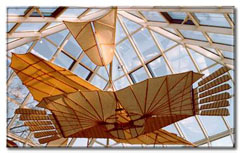The Otto Lilienthal Museum is located in Anklam, Germany, and is dedicated to the life and legacy of Otto Lilienthal (1848–1896), who is widely regarded as a pioneer of aviation. The museum celebrates his groundbreaking work in aeronautics and his role as the first person to achieve controlled, sustained flight with a glider
Otto Lilienthal Museum
Ellbogenstraße 1
17389 Anklam
+49-3971 245500
May
- Tuesday – Friday 10:00 – 17:00
- Saturday, Sunday 13:00 – 17:00
June – September
- Monday – Friday 10:00 – 17:00
- Saturday, Sunday 13:00 – 17:00
November – April
- Wednesday – Friday 11:00 – 15:30
- Sunday 13:00 – 15:30
Closed December 24th and 31st
Admission fee
Gift shop

Aircraft collection

| D-FONG
D-IXTT D-HOAG D-ESOT DDR-TED – – | Antonov An-2TD
High Performance Aircraft TT62 Alekto Kamov Ka-26 Let Z-37A Cmelak PZL 106 Kruk Raab RK-9a Grasmucke SZD-24 “Foka” |
Gliders of Otto Lilienthal
| Grosser Doppeldecker
kl. Schlagflugelapparat Derwitzer Apparat Vorflugelapparat Maihohe/Rhinow-Apparat Normalsegelapparat Grosser Doppeldecker Sudende – Apparat Normalsegelapparat kleiner Doppeldecker Sturmflugel Kleiner Schlagflugelapparat |
Hang Gliders
| Harker World Cup
Knuth – Standart “Sierra” Bamboo Butterfly Bennett 210 UP Redtail Standard (turmlos) Huber Standard Swiss Delta Knuth Standard Bicla Standard Condos UP Super Redtail Mydra Standard Bavaria Delta Savoie Diamant Bora 100 Sun Standard Knuth Swallowtail Bora Swallowtail Bicla Eagle 1 Skysurfer Danis Manta Skyglider Ikarus 100 Pinzgauer Bora Moskito Steinbach WM 90 Bergfex Bicla Eagle II Dragonfly MK I Flamingo 1 Sunflower Sun Swift Ikarus 200 Quicksilver Skyglider Schatzinger Stern Rogallo Eigenbau Seagull VII Flamingo Sport Dragonfly MK II b Sky Bird II Standard 84/90 Brasil Harker World Cup 90 Happy Duck Nimbus Skyliner Eagle Cloud Falke 2 Phoenix SX Gull HA 19 Falcon III Cirrus III Cirrus 1 Hai Bicla Adler Merlin Soarmaster PP-106 Aar Sonic Stratos N Ikarus 300 Ikarus 300 S Falcon IV Phoenix VI B Bicla Bergstar 1 Bicla Bergstar 2 UP Spyder Rhonadler Superfex Midas Falke 3 Hawk 77 Falcon V Bicla Comet Delta-Wing SC BM III Ikarus 600 b Olympus 180 Moyes Stingray Jet Euro 1 Phonix Mariah 170 Gryphon III Super Gryphon 180 Sonder Gryphon Antares Cyclone OWL Zetka Taifun Swiss Lancer 4 Manta Fledge 2 b Holz Fledge Ente Bora Pirat Highster Sunbird Nova Zephyr Thalhofer Junior Ranger A Wings DDR Eigenbau Condor Bicla Maxi II Bennett Lazor 170 Bergfalke CSSR-Floater Tschech. World Cup Windspiel 2 Atlas 16 Moyes Maxi Firebird C 12 Comet Aquila 3 Cloud II Firebird II Laser 190 Super Scorpion Swiss Super Scorpion Swiss Super Scorpiönli Atlas 18 Euro II Fafnir Moyes Mega Ikarus 800 Scout Firebird CX 17 Hornet 15 Concord II Azur 15 Clubman C 164 Weltrekordgerat Fafnir Fun 14 Spot Bullet Racing Sierra Magic III Spirale 23 Minifex Express Racing Hermes 16 Spirit Profil Sport 17 Magic 4 Zephir Laser Prototyp Moyes GTR 162 Excel 151 Vega MX II New Wave 15 Pamir Milan Condos Knuth Standard Bavaria Delta Skylider Bicla Adler Flamingo Sonic Cirrus 3 Sun mit Fenster Sun I Maxi II Cirrus III Stiller Abdeckplane Weltrekordgerat Nase 4 Bicla Standart Moyes GTR 162 Wings Typhoon Danis Manta Ikarus 300 S Airwave Calypso mit Zubehor Huber Standard Thalhofer “Flamingo” Saphir 16 US-Lancer “Experience” Typ JuLu 3 |
Features of the Otto Lilienthal Museum:
- Exhibits on Lilienthal’s Life and Work:
- The museum displays Lilienthal’s glider designs, including replicas and models of his flying machines.
- Original documents, photographs, and artifacts from Lilienthal’s life illustrate his journey as an engineer and inventor.
- Interactive Displays:
- Visitors can engage with hands-on exhibits that explore the principles of aerodynamics.
- Simulations allow guests to experience the challenges and successes of early aviation.
- Historic Context:
- The Otto Lilienthal Museum places Lilienthal’s work within the broader context of the history of flight.
- It highlights his influence on later aviation pioneers, such as the Wright brothers.
- Educational Programs:
- Workshops and guided tours cater to families, school groups, and aviation enthusiasts.
- The museum emphasizes science education and the spirit of innovation.
- Architecture and Atmosphere:
- The Otto Lilienthal Museum’s building itself is an architectural homage to aviation, reflecting the themes of flight and innovation.
Anklam, Lilienthal’s birthplace, serves as the perfect location for this tribute to his achievements. Whether you’re an aviation history enthusiast or curious about the roots of human flight, the Otto Lilienthal Museum offers a fascinating insight into one of the most important figures in the field.
The Otto Lilienthal Museum‘s permanent exhibition shows all of Lilienthal’s known aircraft designs in reconstruction as well as his aerodynamic test rigs. The museum presents Lilienthal’s flights as a turning point from the history of the desire to fly, for which there are 4,000-year-old documents, to the technical history of human flight. The house sees itself as a technical personnel museum, which is also dedicated to the important other activities of the brothers Otto and Gustav Lilienthal (social reform, construction, toys). In the exhibition section Life Courses there is, among other things, the only preserved steam engine from Lilienthal’s production, which was acquired in Australia in 2004.
About 3 km away from the museum, at the Anklam airfield, there is an outdoor area of the museum, the Aeronauticon educational and adventure garden.
The museum contains replicas of all known Lilienthal’s flying machines and his flight-physical experimental setups. The museum also owns the most important collection of original documents on Lilienthal’s life and work, alongside that of the Deutsches Museum in Munich.
On the subject of hang gliders – Lilienthal’s principle of flight in today’s description – the museum has had a collection of more than 150 flying machines since 1999. Under the title “Ikareum“®, the town of Anklam is pursuing the project to dedicate Otto Lilienthal’s baptistery, the Nikolai Church, to this exhibition theme in future.
Within eleven years until 2014, the well-known Lilienthal’s estate was completely digitised, including the objects located outside, in various countries.
At the beginning of 2018 the Otto Lilienthal Museum received the estate of the locksmith and aircraft mechanic Paul Beylich (1874-1965) from his great-granddaughter Andrea Frey. Beylich was one of Lilienthal’s closest colleagues and probably the only witness to the crash near Rhinow.
